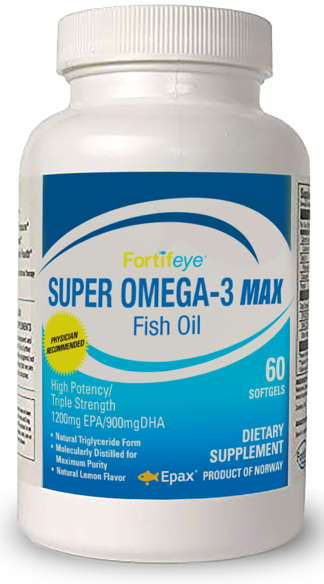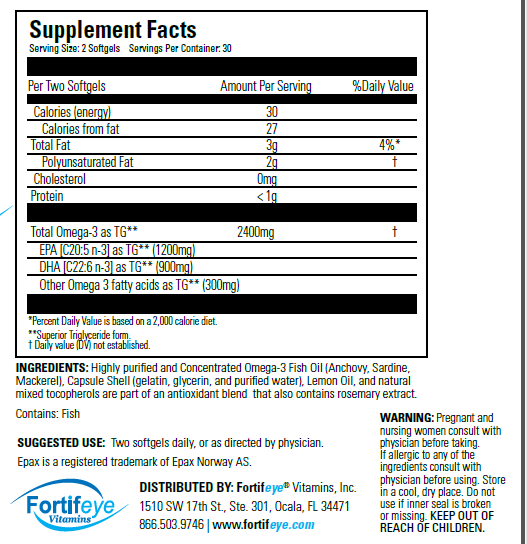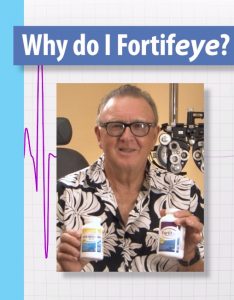One of the most potent and purest Re-esterfied Triglyceride Form (rTg) omega 3 fish oils available in the world today!

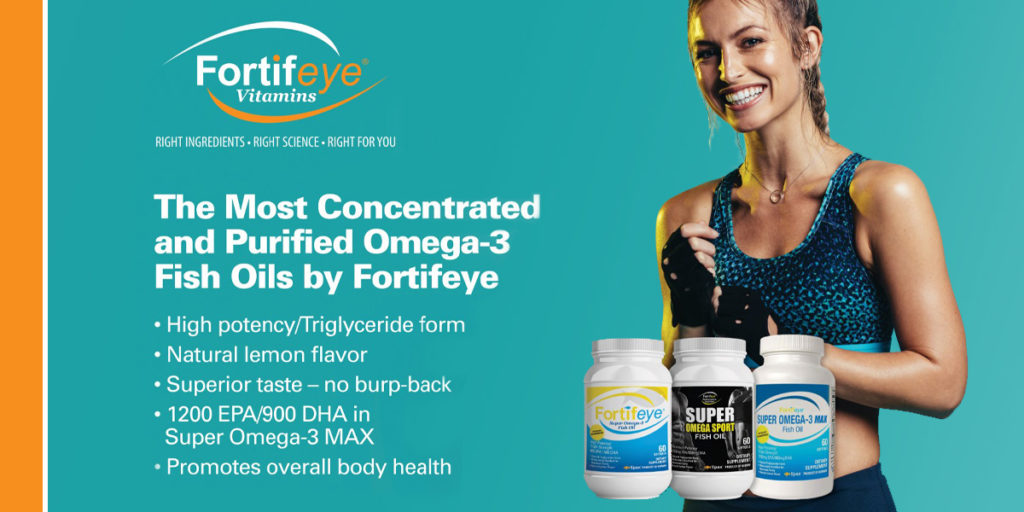
Download Fortifeye Omega-3 Max Info Sheet (pdf)
Testimonials
Press Release on the all New Fortifeye Super Omega 3 Max:
Fortifeyes Super Omega-3 Max the Most Potent Omega-3 Supplement in the Industry
Fortifeye Super Omega 3 MAX has been developed after years and years of research . This is one of the most potent and purest Re-esterfied Triglyceride Form (rTg) omega 3 fish oils available in the world today. This omega 3 supplement is purified and concentrated in a state of the art facility in Norway . This new technology allows for more EPA and DHA in the same size capsule as the original Fortifeye Super Omega. This new omega 3 max will allow for much better compliance since the high dosage of omega three can be delivered with less capsules . Fortifeye Super Omega MAX will be 50% more potent than Fortifeye Super Omega and retails for only $35 . This new omega is more concentrated and less expensive that most competitors . A lot of new science is proving the need for higher levels of omega 3 both EPA and DHA May be beneficial For our health. Fortifeye super omega 3 Max has 1200 mg of EPA and 900 mg of DHA per dosage!! Start to gain some of the many potential health benefits from the correct form of omega 3 . Order Fortifeye Super Omega Max today. This new formulation of omega 3 is also currently being used by many athletes to aid in post recovery .
Supporting Articles & Publications
Higher levels of omega-3 acids in the blood increases life expectancy by almost five years
A 1% increase in this substance in the blood is associated with a change in mortality risk similar to that of quitting smoking.
Consuming omega-3 fatty acids could prevent asthma, study suggests
New research suggests that a higher dietary intake of long chain omega-3 fatty acids in childhood may reduce the risk of developing subsequent asthma, but only in children carrying a common gene variant.
Authoritative new analysis links increased omega-3 intake to cardioprotection and improved cardiovascular outcomes
Study indicates that EPA and DHA supplementation reduces multiple types of cardiovascular risk
A new study published in Mayo Clinic Proceedings provides the most comprehensive analysis of the role of omega-3 dosage on cardiovascular prevention to date. The meta-analysis, which is an in-depth review of 40 clinical trials, provides authoritative evidence for consuming more EPA (eicosapentaenoic acid) and DHA (docosahexaenoic acid) omega-3 fats.
Analysis predicts purified fish oil could prevent thousands of cardiovascular events
Researchers have conducted a statistical analysis that predicts more than 70,000 heart attacks, strokes and other adverse cardiovascular events could be prevented each year in the U.S. through the use of a highly purified fish oil therapy.
Degenerative rotator cuff tears are associated with a low Omega-3 Index
Patients with full thickness degenerative rotator cuff tears had a significantly lower Omega-3 Index than controls without rotator cuff tendinopathy. Whether a lower Omega-3 Index represents an independent risk factor for degenerative rotator cuff tears should be further investigated, e.g. in a longitudinal study.
View Full Article on PLEFA.com
A Meta-Analysis of Randomized Controlled Trials and Prospective Cohort Studies of Eicosapentaenoic and Docosahexaenoic Long-Chain Omega-3 Fatty Acids and Coronary Heart Disease Risk
Objective: To conduct meta-analyses of randomized controlled trials (RCTs) to estimate the effect of eicosapentaenoic and docosahexaenoic acid (EPAþDHA) on coronary heart disease (CHD), and to conduct meta-analyses of prospective cohort studies to estimate the association between EPAþDHA intake and CHD risk.
EPA and Treatment of Major Depressive Disease
Peet,Malcolm; Stokes, Caroline
Omega-3 fatty acids in the treatment of psychiatric disorders
Drugs 2005;65:1051-1059
The importance of omega-3 fatty acids for physical health is now well recognised and there is increasing evidence that omega-3 fatty acids may also be important to mental health. The two main omega-3 fatty acids in fish oil, eicosapentaenoic acid (EPA) and docosahexaenoic acid (DHA) have important biological functions in the CNS. DHA is a major structural component of neuronal membranes, and changing the fatty acid composition of neuronal membranes leads to functional changes in the activity of receptors and other proteins embedded in the membrane phospholipid. EPA has important physiological functions that can affect neuronal activity. Epidemiological studies indicate an association between depression and low dietary intake of omega-3 fatty acids, and biochemical studies have shown reduced levels of omega-3 fatty acids in red blood cell membranes in both depressive and schizophrenic patients.Five of six double-blind, placebo-controlled trials in schizophrenia, and four of six such trials in depression, have reported therapeutic benefit from omega-3 fatty acids in either the primary or secondary statistical analysis, particularly when EPA is added on to existing psychotropic medication. Individual clinical trials have suggested benefits of EPA treatment in borderline personality disorder and of combined omega-3 and omega-6 fatty acid treatment for attention-deficit hyperactivity disorder. The evidence to date supports the adjunctive use of omega-3 fatty acids in the management of treatment unresponsive depression and schizophrenia. As these conditions are associated with increased risk of coronary heart disease and diabetes mellitus, omega- 3 fatty acids should also benefit the physical state of these patients. However, as the clinical research evidence is preliminary, large, and definitive randomised controlled trials similar to those required for the licensing of any new pharmacological treatment are needed
DRY EYE SYNDROME – DES
People with DES complains most frequently of a scratchy or foreign body sensation. Redness, pain, itching, inability to produce tears, light sensitivity, and blurred vision with difficulty driving after dark are common symptoms. The symptoms are located mainly to the pain sensitive cornea.
Recent animal experiments have demonstrated that DES is not exclusively a disease located to the cornea since inflammatory cells and immunological chemical mediators were found in the tear fluid. Since cornea does not contain tissue engaged in an inflammatory process the lacrimal gland and the conjunctiva have to participate in the syndrome even though symptoms relate to cornea.
A number of controlled clinical studies have been published where these fatty acids have been given in a placebo-controlled design. Rahul Bhargava and colleagues (1) included 264 DES subjects given 1g daily of marine omega3 fatty acids mainly eicosapentaenoic acid (EPA) and compared effects on symptoms, tear production and corneal cell integrity. A large control group of 254 individuals were given matching placebo. After three months, there was a significant reduction in symptom score in the omega3 group along with improvement in tear production and corneal cell integrity. Kawatita K et al (2) included 27 DES patients in a study providing half of the group with a product containing 1.3g of EPA and 0,5 g of docosahexaenoic acid (DHA) daily for 12 weeks. Symptoms were significantly reduced in the intervention group.
Kangari H and collaborators included sixty-four patients with dry eye symptoms (3). The subjects were randomized into two groups: 33 persons in the treatment group given 2 capsules of omega-3 (each containing 180 mg EPA and 120 mg DHA and 31 persons in the placebo group. The tear break-up time (TBUT), Schirmer’s score, and Ocular Surface Disease Index (OSDI) were measured 1 month after the intervention. Repeated-measures analysis of variance showed that improvements in TBUT, OSDI, and Schirmer’s scores were significantly better in the treatment group than in the placebo group. The changes in the treatment and placebo groups were 71% and 3.3% for TBUT (P<0.001), 26% and 4% (P=0.004) for dry eye symptoms, and 22.3% and 5.1% for Schirmer’s score (P=0.033), respectively. In conclusion, his study demonstrated that omega-3 fatty acids for 30 days was associated with a decrease in the rate of tear evaporation, an improvement in dry eye symptoms, and an increase in tear secretion.
In another study by Bhargava R and Kumar P 496 contact lens carriers with DES were randomly allocated to treatment with marine omega3 fatty acids (0.6g daily) or placebo for six months (4). The study demonstrated a significant improvement in dry eye symptoms and an increase in tear secretion in the omega3 treated group. The Bhargava group included 428 computer workers with DES in another study (5). Half the group were given the same dose of omega3 fatty acids as in study 7. The rest were provided with matching placebo capsules and followed for three months. There was a significant improvement in symptoms followed by increased tear production in the active treatment group. A recent study by Bhargava R and collaborators evaluated the effect of higher omega 3 fatty acid dose than in their previous studies namely 2,400 mg/day for 45 days on dry eye symptoms, tear production, stability, and conjunctival cytology in young and middle-aged visual display terminal (VDT) users (6). It was a randomized, double-blind, interventional study where 256 VDT users were randomized to receive omega-3 while 266 subjects received matching placebo capsules. Patients were evaluated at baseline, 30 days, and 45 days. The primary outcome measure was an improvement in dry eye symptoms. Secondary outcome measures were improvement in the Nelson grade on conjunctival impression cytology, Schirmer test values, and tear film breakup time (TBUT). In the omega3 group, the mean symptom score differed significantly between active treatment and placebo (P<0.005) as did the TBUT and Nelson grade evaluation. Schirmer test values did not differ significantly after adjustment for multiple comparisons. Consumption of 2,400 mg/day of O3FA supplement improved symptoms, tear stability, and conjunctival cytology but not tear production in symptomatic VDT users.
In a meta-analysis of published studies using a randomized, placebo-controlled design, Liu A and Yi J included a total of 790 participants in seven independent studies published between 2007 and 2013 (8). The authors concluded that based on the experience from these studies Omega3 fatty acid seemed to offer an effective therapy for DES.
Article below posted on the European Journal of Clinical Nutrition website.
Association of blood levels of marine omega-3 fatty acids with coronary calcification and calcium density in Japanese men
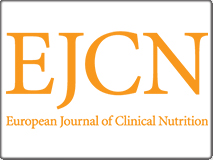
Clinical trials of eicosapentaenoic acid (EPA) among high-risk groups in Japan in which consumption of mairne-omega-3 fatty acids (OM3) is much higher than other countries showed slower progression of coronary atherosclerosis. We aimed to determine the cross-sectional associations of coronary artery calcification (CAC) and calcium density with OM3, EPA, and docosahexaenoic acid (DHA), two principal OM3, in the general population in Japan.


